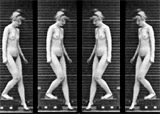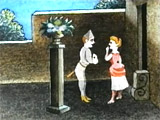
|
Special Effects (F/X) - Milestones in Film 1880s-1890s |

|
Eadweard Muybridge's The Horse in Motion (1878), and Primitive Motion Studies (from 1884-1887) One of a number of early achievements that helped pave the way for animation was by Briton Eadweard Muybridge who famously photographed The Horse in Motion in 1878. In a series of pictures, he captured frame by frame, how a horse's four hoofs were actually off the ground at the same time. In other test footage, including The Human Figure in Motion - Descending Stairs and Turning Around, he photographed cinematic glimpses of naked men and women in motion, such as this female and male walking up and down stairs. |
  
|

|
Monkeyshines No. 1 (1889 or 1890) Thomas Edison's assistant William K.L. Dickson filmed his first experimental Kinetoscope trial film, Monkeyshines No. 1, the only surviving film from the cylinder kinetoscope, and apparently the first motion picture ever produced on photographic film in the United States. It featured the fuzzy movements of laboratory assistant Sacco Albanese, filmed with a system using tiny images that rotated around the cylinder. |

|
Dickson Greeting (1891) The first public demonstration of motion pictures in the US using the Kinetoscope occurred at the Edison Laboratories to the Federation of Women’s Clubs on May 20, 1891. The very short film’s subject in the test footage was director William K.L. Dickson himself (Thomas A. Edison's associate), bowing, smiling and ceremoniously taking off his hat. |

|
|

|
Pauvre Pierrot (1892, Fr.) The inventor of the viewing device called a praxinoscope (1877), French scientist Charles-Emile Reynaud, also created a large-scale system called Theatre Optique (1888) which could take a strip of pictures or images and project them onto a screen. He demonstrated his system in 1892 for Paris' Musee Grevin - it was the first instance of projected animated cartoon films (the entire triple-bill showing was called Pantomimes Lumineuses), with three short films that he had produced:
To create the animations, individually-created images were painted directly onto the frames of a flexible strip of transparent gelatine (with film perforations on the edges), and run through his projection system. The three animated films lasted about 12-15 minutes each. Depending upon one's definition of terms, some consider Pauvre Pierrot the oldest-surviving animated film ever made and publically broadcast. |
 
|
| Fred Ott's Sneeze (1894) (aka Edison Kinetoscopic Record of a Sneeze) One of Thomas Edison's first film strips on celluloid, filmed to be viewed on his invention called the kinetoscope, a device for viewing moving pictures without sound, and patented in 1887. It remains as one of the earliest surviving copyrighted motion pictures (or "flicker"), lasting a duration of five seconds and filmed at sixteen frames per second (80 frames). It was an optical record of Fred Ott, an Edison employee, sneezing comically for the camera. In a few short years, Edison was producing between 200 and 300 films at the Black Maria, the first movie studio established in 1893. |
 |
|

|
Annabelle (Whitford) Moore's Dance Routines (mid-1890s) Many of the earliest nickelodeon films featured the dancing of vaudeville performer Annabelle Whitford Moore (known as "Peerless Annabelle"). She made her debut at the Columbian Exposition in 1893. She was a featured performer on Broadway when she was filmed by William K.L. Dickson in 1894 at Edison's studio in N.J.. Her Serpentine and Butterfly dances were so popular that Dickson filmed her again for the American Mutoscope in 1896. Annabelle's skirt dances are among the earliest artistic works in film history.
Male audiences were enthralled watching these early depictions of a clothed female dancer (sometimes color-tinted) on a Kinetoscope - an early peep-show device for projecting short films. |

|

|
Dickson Experimental Sound Film (1895) The first known (and only surviving) film with live-recorded sound made to test Edison's Kinetophone (with a cylinder-playing phonograph and connected earphone tubes) was this 17-second short film. It was noted as the first film attempting to combine both sound and motion synchronized together. It was filmed in late 1894 or early 1895 at Thomas Edison's laboratory in West Orange, N.J. by Edison's associate William K.L. Dickson. Just before the film began, one can hear: "Are the rest of you ready? Go ahead!" The projector was connected to the phonograph with a pulley system, but it didn't work very well and was difficult to synchronize. It was formally introduced in 1895, but soon proved to be unsuccessful since competitive, better synchronized devices were also beginning to appear at the time. |

|

|
The Execution of Mary Queen
of Scots (1895), aka The Execution
of Mary Stuart In the short sequence, Mary knelt down, and put her head on the block as the executioner raised a large axe. When the axe was brought down, her head rolled off the chopping block to the left - where the executioner picked it up in the final frame and held it up. |
 
|

|
The Vanishing Lady (1896, Fr.) (aka "The Conjuring of a Woman at the House of Robert Houdin") Reportedly, French film-maker and trickster Georges Melies, known as the 'Father of Cinematic Special Effects,' accidentally discovered the stop-motion effect when his first rudimentary camera jammed during filming. After fixing the jam and the action resumed, he realized that he had inadvertently discovered a neat camera trick, causing objects to change position (a man changed into a woman, and a bus changed into a hearse). Melies' first intentional use of this discontinuity technique was for the special visual effect in this short film. It was a simple illusion or magic act - a lady on stage disappeared. In the film, a tuxedoed magician (Georges Melies) brought a woman (Jeanne d'Alcy) onto a stage (with a painted backdrop - an artificial set), seated her in a chair and covered her with a large tablecoth. Then, when he removed the sheet, she vanished or disappeared. Actually, the camera was imperceptibly stopped (a "jump cut" or stop-substitution effect) and started again, allowing the lady to 'vanish' from the stage in the interim. Afterwards, he had a skeleton reappear in the chair (with a second jump cut). He covered it with the sheet, and then - with a third jump cut - brought back the lady. They both bowed and left the stage and then returned for a second bow and curtsy. |
  
|

|
The Astronomer's Dream (1898, Fr.) (aka A Trip to the Moon, or La Lune à un Mètre) French filmmaker Georges Melies' 3-minute science-fiction film was about a medieval astronomer (Melies himself) who fell asleep and had a nightmarish dream about the Moon, a Fairy Queen (guardian angel), and a devil character. It was shot from a fixed perspective, although it employed many stop-motion substitutions ('trick photography'), to create the illusion that objects disappeared (or reappeared), or were moving (stop-motion animation). It was Melies' most elaborate and sophisticated dream or trick film to date. In one part of the film, the moon descended into the astronomer's work area and consumed him and his telescope. It was the precursor to Melies' 1902 Le Voyage Dans La Lune (A Voyage to the Moon). |
 
|
The Humpty Dumpty Circus (1898) This theatrical 'cartoon' from Vitagraph, a lost silent film, has been claimed by Guinness to be "the first animated film using the stop-motion technique to give the illusion of movement to inanimate objects." Reportedly, directors/filmmaker Albert E. Smith (with James Stuart Blackton) conceived the idea, borrowing one of their young daughter's circus toys and shooting the acrobats and animals in barely changed positions one frame at a time. |
||

|
Santa Claus (1898, UK) (aka The Visit of Santa Claus) This early one-minute single-scene short by British film-maker George Albert Smith told a simple narrative of two children being put to bed by a nanny, and a late-night dream-vision visit by a thin, robe-wearing Santa Claus who entered via the chimney to deliver presents. It was notable for many reasons: it featured the first opening title screen with lettering, and also contained a number of visual effects (many of which were also being perfected by French filmmaker Georges Melies):
With a second jump-cut, Santa Claus disappeared from the room. |
   
|
The Kiss in the Tunnel (1899, UK) This was another one-minute short film by pioneering UK filmmaker George Albert Smith, this time with three separate shots. It was one of the earliest surviving examples of film editing to enhance the narrative. It was one of the first films to edit together several related shots. The humorous short began with a steam locomotive exiting from a tunnel, then a moving or tracking dolly shot (one of the first instances of what was called a "phantom ride" - a camera/cameraman were positioned on the front of the train to shoot the scene from the POV of the train) of a second train smoothly entering into the dark tunnel, and a jump-cut to an inserted sequence of a well-dressed bourgeois couple (G.A. Smith and his wife), after a day of shopping, seated in one of the train car rooms (an artificial set). They shared a few kisses (the Victorian-era wife protested slightly, but was willing to accept the kisses) during the darkness (painted windows created the effect). The film made it obvious that it was a separate but continuous scene - and the two were on a train carriage in the middle of the tunnel. The gentleman had removed his top hat for the kiss and set it down, and realized he had sat on his hat and crushed it. The two returned to reading a book and a newspaper. The film ended with another jump-cut to darkness, and the train emerging from the tunnel into the daylight - a second book-ended use of the "phantom ride" technique.
|
    
|
|